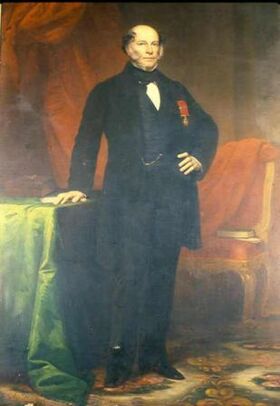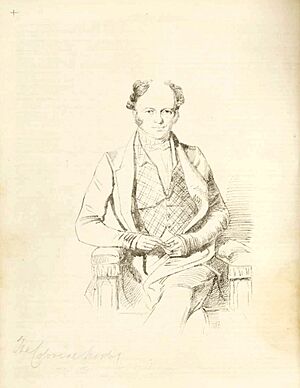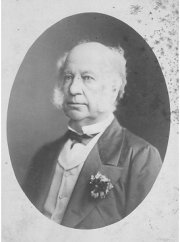Edward Deas Thomson facts for kids
Quick facts for kids
Sir
Edward Deas Thomson
|
|
|---|---|

Sir Edward Deas Thomson, ca. 1865
|
|
| Colonial Secretary of New South Wales | |
| In office 2 January 1837 – 5 June 1856 |
|
| Monarch | |
| Governor |
|
| Preceded by | Alexander Macleay |
| Succeeded by | Stuart Donaldson |
| Chancellor of the University of Sydney | |
| In office 1865–1878 |
|
| Preceded by | Francis Merewether |
| Succeeded by | William Montagu Manning |
| Vice-Chancellor of the University of Sydney | |
| In office 1863–1865 |
|
| Preceded by | Francis Merewether |
| Succeeded by | John Plunkett |
| Member of the Legislative Council of New South Wales | |
| In office 3 January 1837 – 16 July 1879 |
|
| Personal details | |
| Born | 1 June 1800 Edinburgh, Scotland |
| Died | 16 July 1879 (aged 79) Sydney, New South Wales, Australia |
| Education | Harrow School |
| Occupation | Government administrator, politician, university administrator |
| Awards | |
Sir Edward Deas Thomson (born 1 June 1800 – died 16 July 1879) was an important figure in early Australian history. He was born in Scotland and later became a leading government official and politician in Australia. He also played a big role in the University of Sydney.
| Top - 0-9 A B C D E F G H I J K L M N O P Q R S T U V W X Y Z |
Early Life and Career
Edward Deas Thomson was born in Edinburgh, Scotland. His father, Sir John Deas Thomson, worked as an accountant for the navy. Edward went to school in Edinburgh and then to Harrow School in England. He also studied for two years in Caen, France.
After his studies, Thomson worked with his father. They helped to improve how the navy kept its financial records. In 1826, he traveled to the United States and Canada. When he returned in 1827, he took a job in Demarara. However, he soon swapped this for a job in New South Wales, Australia. He became the clerk for the legislative and executive councils there.
Life in Australia
Thomson arrived in Sydney, Australia, in December 1828. He quickly proved to be a very skilled and helpful officer. In January 1837, he became the Colonial Secretary. This was a very important job, and he held it for almost 20 years. He earned a good salary of £1500 a year.
Even though some people questioned how he got the job, he did his work very well. He was known for being tactful and respectful. During the time of Governor Sir George Gipps, Thomson was so respected that even those who disagreed with him found it hard to oppose him.
His experience was especially helpful when the new constitution bill was being created. He traveled to England with William Wentworth to help get the bill approved by the British Parliament. In 1854, people showed their appreciation for him. They raised money, and half of it was used to buy him a special gift. The other half was given to the University of Sydney to create a scholarship in his name.
After his retirement in 1856, Thomson was offered the chance to form the first government under the new constitution. However, he was unable to do so. He then joined the New South Wales Legislative Council. He also served as vice-president in the Parker government. In 1857, he suggested forming a committee to discuss the idea of Australian federation. This committee supported the idea of a federal assembly. However, a new government came into power, and the idea was put on hold.
Later Years and Legacy
Thomson remained a member of the legislative council until he died. However, his health had suffered from his demanding work as Colonial Secretary. He no longer took a leading role in politics. He received a good pension after retiring in 1856. This gave him time to focus on other interests.
He was one of the first members of the senate of the University of Sydney when it was founded in 1850. He became the vice-chancellor in 1863. From 1865 to 1878, he served as the chancellor of the university. He also enjoyed sports and was president of the Australian Jockey Club for several years. He was also President of the Australian Club in Sydney.
During his visit to England, he received an honor called the Companion of the Order of the Bath (CB). In 1874, he was given an even higher honor, becoming a Knight Commander of St Michael and St George (KCMG).
Family Life
Edward Deas Thomson married Anne Marie Bourke. She was the second daughter of Governor Sir Richard Bourke. Anne Marie was a strong activist. She helped start the Sydney Founding Institute, which is now called The Infants' Home Child and Family Services.
Edward and Anne Marie had two sons and five daughters. One of their daughters, Elizabeth, became the mother of Edward Grigg, 1st Baron Altrincham. Another daughter, Susan Emmeline, married the politician and pastoralist William John Macleay. Their daughter Eglantine Julia married the politician William Campbell.
A painting of Sir Edward Deas Thomson can be seen in the great hall of the University of Sydney. He passed away in Sydney on 16 July 1879.
See also
- Members of the New South Wales Legislative Council
- Thomson River
- The Wool Road (New South Wales)
- Vincentia, New South Wales



